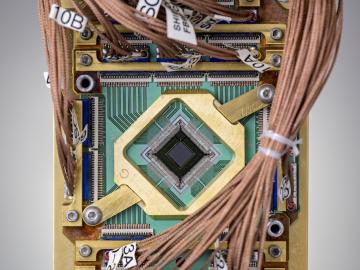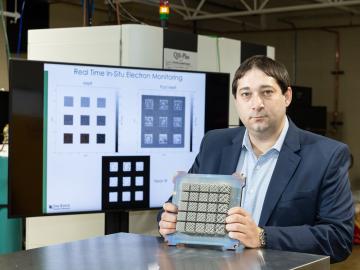
Filter News
Area of Research
- (-) Energy Science (49)
- (-) Materials (95)
- (-) Neutron Science (37)
- (-) Nuclear Science and Technology (13)
- (-) Supercomputing (38)
- Advanced Manufacturing (7)
- Biological Systems (1)
- Biology and Environment (26)
- Computational Biology (2)
- Computational Engineering (1)
- Computer Science (1)
- Electricity and Smart Grid (1)
- Functional Materials for Energy (1)
- Fusion and Fission (27)
- Fusion Energy (15)
- Isotope Development and Production (2)
- Isotopes (9)
- Materials Characterization (1)
- Materials for Computing (16)
- Materials Under Extremes (1)
- National Security (14)
- Sensors and Controls (1)
- Transportation Systems (1)
News Topics
- (-) Biomedical (37)
- (-) Composites (19)
- (-) Fusion (17)
- (-) Irradiation (1)
- (-) Materials Science (103)
- (-) Security (11)
- 3-D Printing/Advanced Manufacturing (94)
- Advanced Reactors (18)
- Artificial Intelligence (45)
- Big Data (28)
- Bioenergy (37)
- Biology (25)
- Biotechnology (6)
- Buildings (39)
- Chemical Sciences (35)
- Clean Water (11)
- Computer Science (113)
- Coronavirus (31)
- Critical Materials (21)
- Cybersecurity (16)
- Energy Storage (89)
- Environment (82)
- Exascale Computing (27)
- Fossil Energy (3)
- Frontier (33)
- Grid (42)
- High-Performance Computing (47)
- Hydropower (3)
- Isotopes (17)
- ITER (1)
- Machine Learning (22)
- Materials (105)
- Mathematics (4)
- Mercury (3)
- Microelectronics (1)
- Microscopy (31)
- Molten Salt (7)
- Nanotechnology (47)
- National Security (11)
- Neutron Science (131)
- Nuclear Energy (56)
- Partnerships (16)
- Physics (37)
- Polymers (23)
- Quantum Computing (21)
- Quantum Science (37)
- Simulation (18)
- Software (1)
- Space Exploration (14)
- Statistics (1)
- Summit (44)
- Transportation (75)
Media Contacts

Scientists have found new, unexpected behaviors when SARS-CoV-2 – the virus that causes COVID-19 – encounters drugs known as inhibitors, which bind to certain components of the virus and block its ability to reproduce.

Oak Ridge National Laboratory researchers combined additive manufacturing with conventional compression molding to produce high-performance thermoplastic composites reinforced with short carbon fibers.

Twenty-seven ORNL researchers Zoomed into 11 middle schools across Tennessee during the annual Engineers Week in February. East Tennessee schools throughout Oak Ridge and Roane, Sevier, Blount and Loudon counties participated, with three West Tennessee schools joining in.

Oak Ridge National Laboratory researchers have demonstrated that a new class of superalloys made of cobalt and nickel remains crack-free and defect-resistant in extreme heat, making them conducive for use in metal-based 3D printing applications.

On Feb. 18, the world will be watching as NASA’s Perseverance rover makes its final descent into Jezero Crater on the surface of Mars. Mars 2020 is the first NASA mission that uses plutonium-238 produced at the Department of Energy’s Oak Ridge National Laboratory.

A multi-institutional team became the first to generate accurate results from materials science simulations on a quantum computer that can be verified with neutron scattering experiments and other practical techniques.

Three technologies developed by ORNL researchers have won National Technology Transfer Awards from the Federal Laboratory Consortium. One of the awards went to a team that adapted melt-blowing capabilities at DOE’s Carbon Fiber Technology Facility to enable the production of filter material for N95 masks in the fight against COVID-19.

Growing up in the heart of the American automobile industry near Detroit, Oak Ridge National Laboratory materials scientist Mike Kirka was no stranger to manufacturing.


Six ORNL scientists have been elected as fellows to the American Association for the Advancement of Science, or AAAS.


